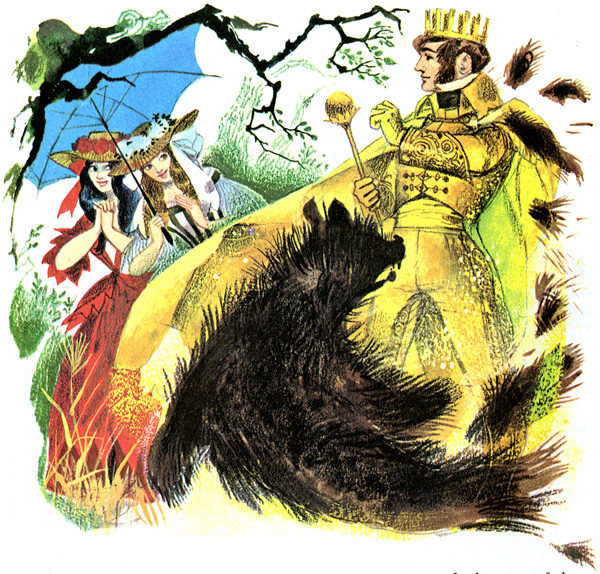Roses are often associated with "Beauty and the Beast," whether people are familiar with the tales in which Beauty requests a rose from her father which he finds in the Beast's garden, or the Disney one that signals the end of the period in which the Beast's curse can be ended. People have found different meanings in the classic fairy tale's rose; it is generally thought to represent Beauty's character, since she
appreciates nature and
is not vain and materialistic like her sisters. Yet it's ironic, because the dresses and jewelry her sisters request are actually practical and will last a long time; flowers, especially roses, are beautiful for a few days and then fade.

I've even seen it argued that Beauty's request for a rose in the middle of winter means that she is giving her father an
impossible request, but in the Villeneuve version it's made clear that her request is made in the summer and her father was simply on a very long journey. ( Yet, in the Italian "Zelinda and the Monster," the request is made in January, and the other sisters' requests were easily found, so it seemed this Beauty was more demanding and less practical).
It's also interesting to look at folktale versions of BATB from around the world in
Surlalune's collection. Some stories don't even have the episode with the request.
In some, Beauty's request is there to emphasize her
wisdom and restraint. Like Villeneuve, who tells us that Beauty realized her father may not be left with much money after paying off his debts, Beauty requests something she thinks will be cheap and easy to find; the heroine in an Italian version states, "this is not the time to spend money, and I love flowers." In most versions, Beauty initially requests nothing, saying she only wants her father to come back safely and/or in good health; but he presses her, for he wants to get her something. In the Italian "Bellindia," both the father and her sisters think her foolish for only requesting a rose tree. In this tale, it seems that money really is no longer a problem, and Bellindia could have had anything she wanted-her father later feels "no inclination to comply with Bellindia's wish."

Such a request, naturally, makes her
sister jealous, and later on when the Beast demands their father's life, the sisters bring it back to Beauty, claiming that her request was made only to set herself apart and now put her father's life in danger. Although they're being unfair, given the nature of sibling relationships, I would suspect there was at least a tiny bit of Beauty that found satisfaction in being a "better person" than her sisters...
Some Beauties
don't ask for roses, although the majority of them do. In the Spanish "Lily and the Bear", the youngest daughter asks for a lily, saying, "We have many roses in our garden but I have never had a lily." (Interestingly, her eldest sister asks for a rose-colored dress).
In the Portuguese "Maiden and the Beast," this daughter is so emphatic that her father not buy her anything, she asks for that which does not exist-"a slice of roach off a green meadow" (?)-yet the supernatural beast is able to provide her father with...whatever that is...in order to demand that she be brought to him. In most versions, it's really the
Beast who manipulates an innocent request into getting a potential date-although to be fair, he's pretty short on options. (The Villeneuve once again explains this away, and we are told that being threatened with her life before coming is the only way a woman can actually break the Beast's spell. It's a pretty complex curse.)
Whatever we may read into Beauty's request, it's usually essential to the story to simply bring her and the Beast together at some point. It shows that Beauty is different from her sisters and connects her to the Beast.
Illustrations by A. L. Bowley
 The majority of humans in history would have only seen reflections of themselves in smooth surfaces, such as water. It's no surprise that in many versions of Snow White, the evil Queen does not ask a mirror to proclaim the fairest of them all, but other objects of nature, such as the sun or moon, or even an animal such as an eagle or trout. It makes more sense to imagine a woman, in a world in which you could never really see what you look like, to wonder how you compare to the other beautiful women you see, and ask someone else for their opinion. The sun, moon, or eagle would have authority to make a pretty good judgment, for they would see a great number of people as they made their way across the sky (not sure about the trout, but that's not as common).
The majority of humans in history would have only seen reflections of themselves in smooth surfaces, such as water. It's no surprise that in many versions of Snow White, the evil Queen does not ask a mirror to proclaim the fairest of them all, but other objects of nature, such as the sun or moon, or even an animal such as an eagle or trout. It makes more sense to imagine a woman, in a world in which you could never really see what you look like, to wonder how you compare to the other beautiful women you see, and ask someone else for their opinion. The sun, moon, or eagle would have authority to make a pretty good judgment, for they would see a great number of people as they made their way across the sky (not sure about the trout, but that's not as common).





















